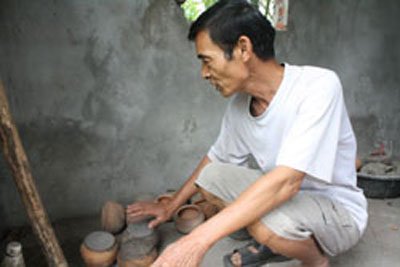
|
| Nguyen Van Thao, head of the cemetery, points to the funereal jars for abandoned foetuses. For years, villagers in Doi Coc hamlet in Soc Son District did not want outsiders to know about their good deed in burying them in one of the village's cemeteries. (Photo: VNS) |
But a few months ago, word about the cemetery reached the media. Suddenly, the topic has received a massive attention.
"We did not want the focus to be on us," said Nguyen Van Thao, who takes care of the cemetery. He was one of the first villagers to become involved in the task. "We try our very best to make sure that our acts help ease the suffering of these souls."
Now, visitors often come to learn how, amid the hassles of daily living, a group of villagers give up their own free time to voluntarily find a peaceful resting place for the souls of the infants.
According to Thao, in the year 2000, a local saw an abandoned foetus on the street side — and buried it.
"We believe that each has a soul," he said. "They were supposed to be born, but for some reason they were not, but they do not deserve to be abandoned."
Word spread and since then, hundreds of villagers here have repeated the act. Some even travel many kilometres to private abortion clinics to rescue aborted foetuses.
The task of collecting the unborn babes often starts at dawn. Burials are usually performed in the afternoon.
In the past, the dead foetuses were buried between regular graves if there was enough space. But then, in 2004, the villagers decided to divide the cemetery into two parts – one for normal burials and the other for the unborn.
Nguyen Thi Hoi, 45, is one of two co-ordinators. She said on some days, as many as 50 foetuses were gathered.
So far, Hoi said more than 50,000 have been buried. Each white tomb holds between 400 to 500 babies. Most are anonymous, but occasionally, there are memorial steles for the identified unborn or those who died at birth.
"Those with steles are often deformed babies whose families heard about the special cemetery," she said. "That way, they have a place to visit and burn incense for the child."
Local authorities are aware of the cemetery, but do not get involved. Nguyen Van An, the hamlet chief, said the local authorities acknowledged the villagers' good acts but all the funds for the tombs were privately donated.
The villagers, most of whom are farmers, use their own money to buy funereal jars and white cloth to wrap and bury the foetuses. Occasionally the jars are donated. Others also donate their time digging the ground on a weekly basis.
The Health Ministry estimates that about 300,000 abortions are carried out for women between 15 and 19 years old each year. But that's only the numbers from public hospitals, not the other 31,000 private clinics in the country.
Most major public hospitals in Ha Noi bury foetuses after abortions, while many private clinics pay no attention to the issue and dump the little bodies at tips.
And that might explain why the number of dead foetuses in the village cemetery is rising.
Thao knows what he and other helpers are doing is only a drop in the ocean. Still, he and others are upset by the growing popularity of abortions, especially among young people.
Some locals believe many abortions are performed on females in industrial zone factories in the district and nearby localities.
Even though media attention can be tiresome, Thao hopes it will turn into real financial support for the cemetery.
"We try doing this to the best of our abilities," he said. "It's a social problem that has to be resolved."
VietNamNet/Viet Nam News